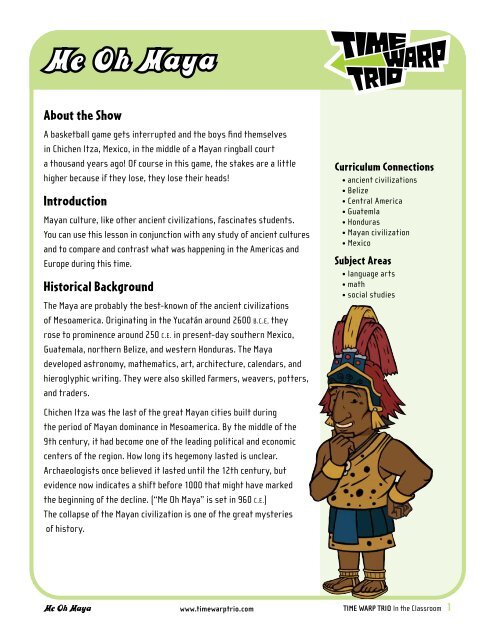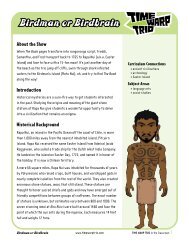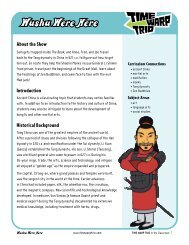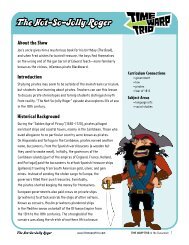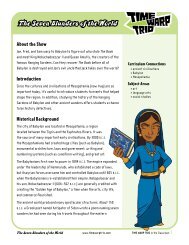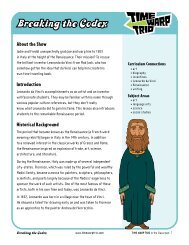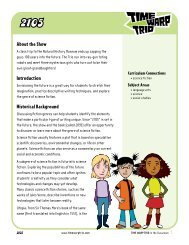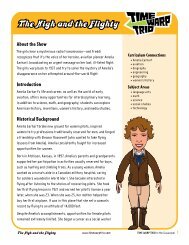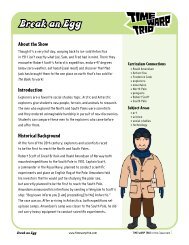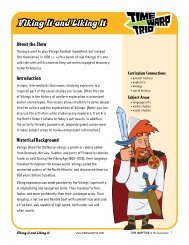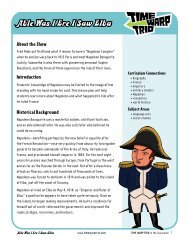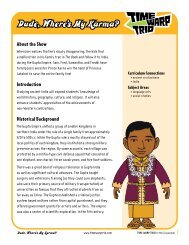You also want an ePaper? Increase the reach of your titles
YUMPU automatically turns print PDFs into web optimized ePapers that Google loves.
<strong>Me</strong> <strong>Oh</strong> <strong>Maya</strong><br />
About the Show<br />
A basketball game gets interrupted and the boys find themselves<br />
in Chichen Itza, <strong>Me</strong>xico, in the middle of a <strong>Maya</strong>n ringball court<br />
a thousand years ago! Of course in this game, the stakes are a little<br />
higher because if they lose, they lose their heads!<br />
Introduction<br />
<strong>Maya</strong>n culture, like other ancient civilizations, fascinates students.<br />
You can use this lesson in conjunction with any study of ancient cultures<br />
and to compare and contrast what was happening in the Americas and<br />
Europe during this time.<br />
Historical Background<br />
The <strong>Maya</strong> are probably the best-known of the ancient civilizations<br />
of <strong>Me</strong>soamerica. Originating in the Yucatán around 2600 B.C.E, they<br />
rose to prominence around 250 C.E. in present-day southern <strong>Me</strong>xico,<br />
Guatemala, northern Belize, and western Honduras. The <strong>Maya</strong><br />
developed astronomy, mathematics, art, architecture, calendars, and<br />
hieroglyphic writing. They were also skilled farmers, weavers, potters,<br />
and traders.<br />
Chichen Itza was the last of the great <strong>Maya</strong>n cities built during<br />
the period of <strong>Maya</strong>n dominance in <strong>Me</strong>soamerica. By the middle of the<br />
9th century, it had become one of the leading political and economic<br />
centers of the region. How long its hegemony lasted is unclear.<br />
Archaeologists once believed it lasted until the 12th century, but<br />
evidence now indicates a shift before 1000 that might have marked<br />
the beginning of the decline. (“<strong>Me</strong> <strong>Oh</strong> <strong>Maya</strong>” is set in 960 C.E.)<br />
The collapse of the <strong>Maya</strong>n civilization is one of the great mysteries<br />
of history.<br />
<strong>Me</strong> <strong>Oh</strong> <strong>Maya</strong><br />
www.timewarptrio.com<br />
Curriculum Connections<br />
• ancient civilizations<br />
• Belize<br />
• Central America<br />
• Guatemla<br />
• Honduras<br />
• <strong>Maya</strong>n civilization<br />
• <strong>Me</strong>xico<br />
Subject Areas<br />
• language arts<br />
• math<br />
• social studies<br />
<strong>Time</strong> <strong>Warp</strong> <strong>Trio</strong> In the Classroom
<strong>Me</strong> <strong>Oh</strong> <strong>Maya</strong><br />
Historical Background continued<br />
As in other cultures, the <strong>Maya</strong> used personal appearance, clothing, and adornments to indicate social<br />
status. Body paint was often used to mark special groups.<br />
The fact that the <strong>Maya</strong> played ball games is known from archeological evidence and carvings.<br />
Although the games may have been played informally, the more formal version featured a specially<br />
constructed ball court. The size of the playing area varied from court to court, but the largest known<br />
court, the Great Ball Court at Chichen Itza, was about the size of a football field. In addition to being<br />
played for sport, the <strong>Maya</strong> ball game was also closely associated with religious rituals and beliefs.<br />
There are about six million <strong>Maya</strong> today living in <strong>Me</strong>xico, Guatemala, and Belize. Each of the 31 <strong>Maya</strong><br />
groups throughout Central America speaks a different, though related, language.<br />
<strong>Me</strong> <strong>Oh</strong> <strong>Maya</strong><br />
Want students to get even more<br />
excited about history?<br />
www.timewarptrio.com<br />
Check out the mayan adventure for kids at<br />
www.timewarptrio.com/adventures/maya/<br />
Put It Back, Jack! and other interactive games to play.<br />
Plentifax 487—the ultimate time traveler’s guide—gives facts<br />
about the way the <strong>Maya</strong>n people lived, and more!<br />
Cool Books that kids will love.<br />
<strong>Time</strong> <strong>Warp</strong> <strong>Trio</strong> In the Classroom
Activity<br />
Basketball Rules<br />
in this activity, students first create a Venn diagram<br />
comparing something familiar (home and school). They<br />
then use a Venn diagram to compare mayan ring-ball and<br />
american basketball.<br />
Instructions<br />
<strong>Me</strong> <strong>Oh</strong> <strong>Maya</strong><br />
1<br />
<strong>Maya</strong>n ring-ball American basketball Objectives<br />
• to draw inferences<br />
• to compare and contrast<br />
attributes and characteristics<br />
• to practice research skills<br />
• to distinguish between similar<br />
and dissimilar characteristics<br />
• to understand a Venn diagram<br />
. Explain that the Venn diagram is a graphic organizer that can be<br />
used to compare the similarities and differences between two things.<br />
Set up two intersecting rings on the floor with the yarn or string.<br />
. Ask a volunteer to write “HOME” on one sentence strip and “SCHOOL”<br />
on another strip with a marker. Have a volunteer place one strip at the<br />
top of each circle.<br />
. Ask the class to brainstorm characteristics of school and home.<br />
Have students write their responses on sentence strips. Answers<br />
may include adults, eating, rooms, books, getting dressed, sleeping,<br />
allowance, homework, teachers, tests, parents.<br />
4. Have students place their sentence strips in the appropriate part<br />
of the diagram. The common characteristics should go in the<br />
overlapping section.<br />
5. Discuss the results with the students. How does the Venn diagram<br />
help demonstrate the differences and similarities of home and school?<br />
6. Organize students into pairs or groups. Tell them that they are going<br />
to create their own Venn diagram to compare <strong>Maya</strong>n ring-ball and<br />
American basketball. They will need to research the characteristics<br />
of each sport.<br />
7. Have partners or groups share their diagrams with the class. You<br />
might want to make a whole-class Venn diagram to see how many<br />
similarities and differences students were able to find.<br />
www.timewarptrio.com<br />
Materials<br />
• 2 different colors of string<br />
or yarn and matching markers<br />
• large sentence strips<br />
Curriculum Standards<br />
• NCSS<br />
Culture: Students explain why<br />
individuals and groups respond<br />
differently to their physical and<br />
social environments and/or<br />
changes to them on the basis of<br />
shared assumptions, values,<br />
and beliefs.<br />
• NCTe/ira<br />
Students conduct research<br />
on issues and interests by<br />
generating ideas and questions<br />
and by posing problems.<br />
<strong>Time</strong> <strong>Warp</strong> <strong>Trio</strong> In the Classroom
Activity<br />
Headlines!<br />
<strong>Me</strong> <strong>Oh</strong> <strong>Maya</strong><br />
2<br />
By writing a newspaper article for the fictitious mayan<br />
News, students familiarize themselves with journalism and<br />
how to write headlines.<br />
Instructions<br />
. Explain that headline editors, not reporters, often write newspaper<br />
headlines. Have students pretend that they are headline editors for<br />
the <strong>Maya</strong>n News. Their words, or glyphs, will be read by thousands of<br />
sports fans. (If possible, display a map of the <strong>Maya</strong>n empire and point<br />
out the vast circulation area of the <strong>Maya</strong>n News.)<br />
. Have students bring in sports sections from different newspapers.<br />
Ask students to read examples of sports headlines. What strong verbs<br />
have the writers used? (Possible examples include: annihilates,<br />
clobbers, crushes, destroys, routs, soars past, squeaks by, tramples,<br />
triumphs over, trounces.) You may want to brainstorm additional<br />
examples.<br />
. Have the class create a word splash of strong verbs. Then, have<br />
partners create a headline for the ring-ball game. Encourage the<br />
student journalists to share their headlines with the class.<br />
Take It Further<br />
Students can translate their headlines into the <strong>Maya</strong>n language<br />
(see Resources). Students can also write their own account of the game<br />
(or an imagined game) to accompany their headline.<br />
www.timewarptrio.com<br />
Objectives<br />
• to improve writing by using<br />
strong verbs<br />
• to become familiar with<br />
journalism<br />
Materials<br />
• newspapers<br />
• map of the <strong>Maya</strong>n empire<br />
(optional)<br />
Curriculum Standards<br />
• NCSS<br />
<strong>Time</strong>, Continuity, and Change:<br />
Students identify and use<br />
processes important to<br />
reconstructing and<br />
reinterpreting the past.<br />
• NCTe/ira<br />
Students use a variety of<br />
technological and informational<br />
resources (e.g. libraries,<br />
databases, computer networks,<br />
video) to gather and synthesize<br />
information and to create and<br />
communicate knowledge.<br />
<strong>Time</strong> <strong>Warp</strong> <strong>Trio</strong> In the Classroom 4
Resources<br />
Recommended Books<br />
For Teachers<br />
Breaking the maya Code<br />
by Michael D. Coe. (Thames & Hudson,<br />
1999) A personal account of the<br />
deciphering of <strong>Maya</strong>n script.<br />
The Cities of ancient mexico<br />
by Jeremy Sabloff. (Thames & Hudson,<br />
1997) An intriguing look at life as it<br />
might have been in the cities of<br />
ancient <strong>Me</strong>xico.<br />
The Courtly art of the ancient maya<br />
by Simon Martin, Mary Miller, and<br />
Kathleen Berrin. (Thames & Hudson,<br />
2004) An illustrated examination of<br />
royal life in ancient <strong>Maya</strong>n culture.<br />
exploring mesoamerica by John M.D.<br />
Pohl. (Oxford University Press, 1999)<br />
In-depth coverage of 18 of the bestknown<br />
archeological sites of ancient<br />
Central America, including <strong>Maya</strong>n<br />
sites.<br />
Handbook to Life in the ancient<br />
maya World by Lynn Foster.<br />
(Facts on Files, 2002)<br />
A useful compendium of essays on<br />
various aspects of the ancient <strong>Maya</strong>n<br />
civilization.<br />
maya monuments by Nigel Hughes.<br />
(Antique Collector’s Club, 2000)<br />
Stunning photographs make this a<br />
useful visual reference book.<br />
Scribes, Warriors, and Kings: The<br />
City of Copán and the ancient maya<br />
by William L. Fash. (Thames & Hudson,<br />
1991) The remarkable archeological<br />
discoveries made at Copán are<br />
presented with black-and-white<br />
photographs, maps, and other<br />
primary sources.<br />
<strong>Me</strong> <strong>Oh</strong> <strong>Maya</strong><br />
For Students<br />
Fiction<br />
The Corn Grows ripe<br />
by Dorothy Rhoads. (Puffin, 1993)<br />
Tigre, a 12-year-old <strong>Maya</strong>n boy living<br />
in a modern day village in Yucataan,<br />
must learn to be a man when his<br />
father is injured.<br />
Heart of a Jaguar by Marc Talbert.<br />
(Aladdin, 1997)<br />
Set just after the great city Chichen<br />
Itza was deserted, 14-year-old Balam<br />
struggles with his family and<br />
community to cope with drought. For<br />
older readers.<br />
The Hummingbird King: a<br />
Guatemalan Legend<br />
by Argentina Palacios. (Troll, 1993)<br />
An evil uncle plots against his nephew<br />
in this illustrated folktale.<br />
Lady of palenque by Anna Kirwan.<br />
(Scholastic, 2004) The Royal Diary<br />
series. Set in Chiapas, 749 A.D., this<br />
is the story of 13-year-old Princess<br />
Green Jay, who is betrothed to an<br />
older man partly because she can<br />
read and write.<br />
me oh maya by Jon Scieszka.<br />
Illustrated by Adam McCauley (Puffin,<br />
2005) The <strong>Trio</strong> land in the middle of<br />
a ball game in ancient <strong>Me</strong>xico—will<br />
they be sacrificed to the gods?<br />
rain player by David Wisniewski.<br />
(Clarion, 1995) Inspired by ancient<br />
<strong>Maya</strong>n culture, this folktale tells the<br />
story of Pik, who challenges the god<br />
of rain to a ball game. For younger<br />
readers.<br />
www.timewarptrio.com<br />
The Well of Sacrifice by Chris Eboch.<br />
(Clarion, 1999) Eveningstar Macaw,<br />
who lives in a 9th century <strong>Maya</strong>n city,<br />
must confront the evil High Priest to<br />
rescue her family and save her own<br />
life. For older readers.<br />
Nonfiction<br />
Gods and Goddesses of the ancient<br />
maya by Leonard Everett Fisher.<br />
(Holiday House, 1999)<br />
A description of the 12 most<br />
important deities, with full-page<br />
paintings inspired by <strong>Maya</strong>n glyphs.<br />
Hands of the maya: Villagers at<br />
Work and play by Rachel Crandell.<br />
(Holt, 2002) Traditional <strong>Maya</strong>n life<br />
and culture are conveyed through<br />
photographs of people at work,<br />
making tortillas, carving stone,<br />
weaving, washing, etc.<br />
a maya by Frederico Navanete Linares.<br />
(Lerner, 1999) Accompanied by<br />
detailed illustrations, the <strong>Maya</strong>n<br />
civilization is portrayed through<br />
historical text and a fictionalized<br />
account of a <strong>Maya</strong>n artisan’s day.<br />
The maya by Peter Chrisp.<br />
(Raintree, 1999) Look into History<br />
series. An illustrated examination<br />
of the <strong>Maya</strong>n civilization.<br />
The maya by Charles George and<br />
Linda George. (Blackbirch Press,<br />
2004) A detailed overview of the<br />
history and culture of the <strong>Maya</strong>.<br />
mayeros: a Yucatec maya Family<br />
by George Ancona. (Lothrop, 1997)<br />
This photodocumentary presents the<br />
life and customs of the descendants<br />
of the <strong>Maya</strong> now living in the Yucatan.<br />
<strong>Time</strong> <strong>Warp</strong> <strong>Trio</strong> In the Classroom 5
Resources<br />
The mystery of the maya:<br />
Uncovering the Lost City of<br />
palenque by Peter Lourie.<br />
(Boyds Mills, 2001) This photoessay<br />
recounts details of the archaeological<br />
dig at a <strong>Maya</strong>n city and provides a<br />
history of the <strong>Maya</strong>.<br />
Tikal by Elizabeth Mann. (Mikaya<br />
Press, 2002) An illustrated guide to<br />
this important city, home to palaces,<br />
plazas and stone pyramids.<br />
Web Sites<br />
CoLLapSe: THe maYa<br />
http://www.learner.org/exhibits/<br />
collapse/mayans_sub.html<br />
This Annenberg site explores the<br />
reason the <strong>Maya</strong> civilzation collapsed.<br />
LoST KiNG oF THe maYa<br />
www.pbs.org/wgbh/nova/teachers/<br />
activities/2804_maya.html<br />
Based on the NOVA program, this<br />
site provides information about<br />
archeologists who are uncovering the<br />
history of Copán, a classic <strong>Maya</strong>n site<br />
in northern Honduras. Includes maps,<br />
lesson plans, teacher’s guide, and a<br />
resource list.<br />
maYaN arT aNd arCHiTeCTUre<br />
maya-art-books.org<br />
Developed by the International<br />
Photographic Archive of <strong>Maya</strong> Art,<br />
this site helps facilitate academic<br />
access to information about <strong>Maya</strong><br />
daily life 1,000 years ago in<br />
Guatemala, Belize, <strong>Me</strong>xico, and<br />
Honduras. Includes links to other<br />
scholarly sites.<br />
<strong>Me</strong> <strong>Oh</strong> <strong>Maya</strong><br />
maYaN NUmBerS<br />
niti.org/mayan/lesson.htm<br />
This site from the National Indian<br />
Telecommunication Institute explains<br />
the <strong>Maya</strong>n numbering system.<br />
(Particularly good for kids)<br />
mYSTerY oF THe maYa<br />
http://www.civilization.ca/civil/<br />
maya/mminteng.html<br />
This site, part of the Canadian<br />
Museum of Civilization, provides<br />
detailed Information about <strong>Maya</strong>n<br />
civilization, and was created in<br />
conjunction with the IMAX film,<br />
“Mystery of the <strong>Maya</strong>.”<br />
readiNG maYa HieroGLYpHS<br />
www.pbs.org/wgbh/nova/maya/<br />
glyphs.html<br />
This site teaches students the<br />
<strong>Maya</strong>n numbering system.<br />
(Particularly good for kids)<br />
<strong>Time</strong> <strong>Warp</strong> <strong>Trio</strong><br />
www.timewarptrio.com<br />
This site for kids includes interactive<br />
games, fascinating facts, and booklists<br />
that help make the past come alive.<br />
©2005 WGBH Educational Foundation. All rights reserved. <strong>Time</strong> <strong>Warp</strong> <strong>Trio</strong> is produced by WGBH in association with<br />
Soup2Nuts for Discovery Kids. Major funding was provided by a grant from the National Endowment for the Humanities. Any views, findings,<br />
conclusions, or recommendations expressed in these classroom materials do not necessarily represent those of the National Endowment for the<br />
Humanities. Based on THE TIME WARP TRIO book series written by Jon Scieszka and illustrated by Lane Smith. <strong>Time</strong> <strong>Warp</strong> <strong>Trio</strong> is a registered<br />
trademark of Chucklebait, LLC. Used with permission. Third party trademarks are the property of their respective owners. Used with permission.<br />
www.timewarptrio.com<br />
please note:<br />
Although these sites were verified at the time<br />
of publication, Web site addresses and content<br />
are frequently subject to change.<br />
<strong>Time</strong> <strong>Warp</strong> <strong>Trio</strong> In the Classroom 6


